

The Mediterranean Coast enjoys a very special climate which has been given the generic name of The Mediterraean Climate due to its peculiar characteristics : very sunny weather and little rain most of the year . Occasionally there are periods of drought like the one we had from 1992 to 1995 .
Tourism in the area has caused an increase in population and the number of holiday resorts with more golf courses , gardens and swimming pools . Consequently the consumption of water also increases . It is necessary to educate the population in the use of water since this is is a limited resource .
Apart from saving water at home and for economic , ecological and touristic reasons , it is fundamental to recycle sewage which may be reused in farming , to water recreational areas (e.g. golf courses) or if it is going to be pumped into the sea not to pollute the beaches .
After visiting the Treatment Plants in Fuengirola and Arroyo de la Miel with our 3rd Forms the students wrote about the process . Below you can read a selection of some of the students ´ works .
The treatment of sewage
An Autobiography
I was a dirty water , useless for human consumption until my best ally the Treatment Plant in Fuengirola recycled me. Now I am clean and ready to be used by farmers .
The process I went through was non-stop .The trip started when I left
home for an unknown place to meet other waters like me . We all went to
specialized machines where our transformation began .
First I went through a channel with a filter where all floating elements
above 3 mm were taken away . There we left all our impurities
.
Then we were taken to big tanks , the decanters , where they let us
rest . There my friend Mud , who had been with me all the way , left for
the depths . We became 40% cleaner .
Next we went to the airing tanks , where rotors with big blades brought air to us and we could finally breathe oxygen in . It was good fun mixing with air since we made a lot of foam together . The bacteria I was still carrying and I was contaminated with , grew and multiplied feeding on the organic living matter .
Then we stopped at the decanters , the place where bacteria and the organic waste was deposited and I was able to leave clean at last . Once I had finished my higienic process I went to the fields to water them and there I met my friend Mud again . He told me all about his complicated depuration process .
From the decanters he was taken to the thickeners where he was concentrated
, then to hermetically-sealed tanks , the digestors , where other bacteria
which do not need air live.
They feed on Mud ´s organic living matter to produce inorganic
materials , methane and carbon dioxide . The temperature in the tanks is
kept between 25and 28 C so that bacteria can grow . The methane produced
is stored in containers and it is later used to heat the boilers.
After the digestion , which lasts between 12 to 30 days , mud is taken away from water , which is sent to decantation tanks . Mud is dried and an odorless fertilizer with a lot of inorganic materials is obtained , which will be used in farming . That´s how I met Mud again in the fields .
And that´s the end of the treatment process . I can be used
again !!
Ahora soy un agua limpia, útil para los agricultores.
Mi proceso de depuración fue continuo, empezó con un viaje desde mi hogar hasta un lugar desconocido, donde encontré aguas en la misma situación que yo. Todas juntas pasamos por unas máquinas especiales donde comenzaría nuestra transformación.
Primero pasé por un canal, en una rejilla me quitaron las partículas que flotaban mayores de tres milímetros, allí se quedó lo más impuro de nosotras.
Nos llevaron después a unos grandes recipientes, los decantadores, donde nos dejaron reposar. Allí mi amigo el lodo, que hasta entonces me había acompañado, se separó y se fue al fondo. Salimos un 40 % más limpias.
Pasamos después a los tanques de oxigenación, donde unos rotores con grandes palas nos mezclaron con el aire, nos oxigenamos, era divertido porque al mezclarme con el aire se formaban grandes cantidades de espuma. Las bacterias que llevaba pudieron crecer y reproducirse alimentándose de la materia orgánica que todavía me contaminaba.
De aquí pasé a otros decantadores, donde las bacterias y los restos orgánicos que me quedaban se depositaron en el fondo y yo pude salir ya limpia.
Cuando acabó mi proceso de limpieza anduve regando los campos y allí me encontré con mi antiguo amigo el lodo. Me contó su complicado camino de depuración desde el momento en que nos separamos, en los tanques de decantación, hasta nuestro reencuentro en el campo.
Desde los decantadores fue llevado hasta los espesadores donde se concentró, de allí pasó a unos tanques cerrados herméticamente, llamados digestores, en los que se desarrollan otras bacterias que no necesitan aire, se alimentan de la materia orgánica del lodo y producen materia inorgánica, gas metano y dióxido de carbono. La temperatura de los tanques se mantiene entre 25 y 28 ºC para que las bacterias puedan crecer. El gas metano que se produce se almacena en unas tanques y se utiliza para calentar las calderas.
Después de la digestión, que dura de doce a treinta días,
se separa el lodo resultante del agua, el agua se envía a los tanques
de decantación y el lodo se seca y se obtiene un abono inoloro con
abundante materia inorgánica que se utiliza en la agricultura. Por
eso me encontré de nuevo con el lodo en los campos de cultivo.
Y con esto termina mi proceso de depuración . ¡Ahora ya
puedo ser reutilizada!.
(Written by Clara Guerrero , Ana Ferrer , Claudia Meza )
(Photographs by Jesús S. Rodriguez , José A. Rodríguez
, Juan A. Moreno . )
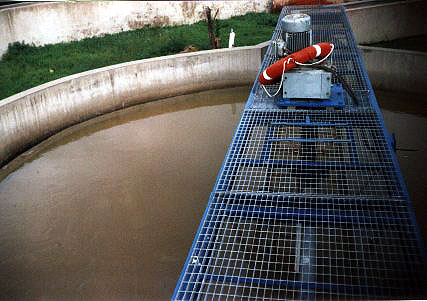 decantación
primaria
decantación
primaria
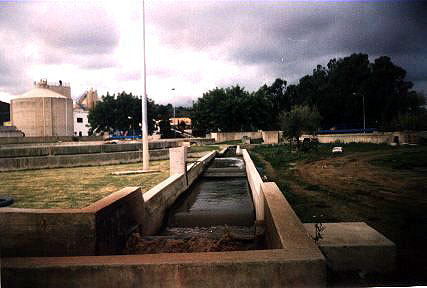 tratamiento
primario
tratamiento
primario
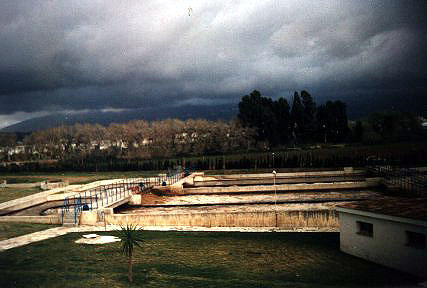 tanques de oxigenación
tanques de oxigenación
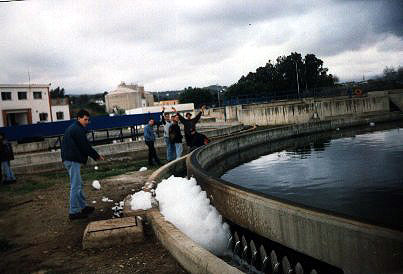 acumulación de espuma
acumulación de espuma
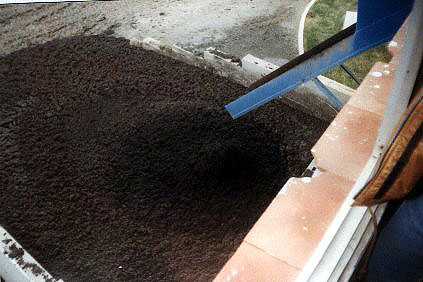 lodo final
lodo final